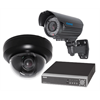Security Camera Technology

Security cameras have become part of our daily lives and can provide an extra level of security, peace of mind, safety, and of course evidence. Choosing a security camera can be confusing with the plethora of technology and styles available. So this guide to camera technology is meant to aid in understanding the technology behind security cameras so you can make a more educated decision.
Let's start with the main technologies, namely traditional analog CCTV, High Definition Analog ( HDCVI, HD-SDI, HDTVI, AHD) and IP Network cameras.
We have also written a guide meant to help select the right security camera(s) for the job here.
Analog CCTV Cameras
Traditionally coax cable was used to carry video, and a pair of wires for power, for analog CCTV cameras. Cable was typically RG59 or RG6 coax cable, and may be known as Siamese cable. Analog CCTV camera image quality was good but nothing to write home about - originally around 330 'lines' of resolution, like old school cable TV. Despite newer cameras claiming 600 lines, 700 lines or even 800 lines, this was mostly hype and limited by the recorder (AKA DVR) which all maxed out at D1 or 480 lines of resolution. In contrast, TVs today are typically 1080p which means 1920 pixels wide by 1080 pixels high. A pixel being a single dot on the screen. So you can see that these systems were limited by the technology and especially the recorders. We still sell analog CCTV equipment primarily for replacements or adding on to older systems.
High Definition over Coax Technologies
Recently we have seen several high definition technologies that can send higher quality images over the same coax cable assuming it is of a decent quality. Those technologies include HDCVI, HDTVI, HDSDI and AHD as of this writing. HDSDI was really the original high definition standard for coax but it is very quickly being replaced by the other three, each of which have their own pros and cons and for the purpose of this article we will not spend any time debating the merits of each. Suffice it to say that now we can get 720p (1280 pixels wide x 720 pixels high) or 1080p (1920 x 1080 pixesl) video, over that same coax cable, by using newer cameras and a compatible recorder which is great news for sites employing older systems, and it's a great opportunity for installers to go back to upgrade client systems. It also has the benefit of being very simple to install and configure as the camera cables plug in to simple ports on the back of the recorder (known as BNC connections) and there is no configuration required for the cameras. So if you are upgrading an older system, HDCVI or AHD is perfect and the simplest to get up and running for everyone. HDCVI and HDTVI security camera systems also tend to be less expensive compared to network camera systems.
IP Network Cameras and Recorders
Last but definitely not least, the most current technology for new installations and high definition video is IP network technology. IP network cameras use computer networking technology as the topology. In other words they connect to a network using CAT5 or CAT6 cables and switches as the backbone. IP network camera resolutions are most often 720p or 1080p like our high definition TVs. These cameras are also measured in pixels or more commonly megapixels or millions of pixels (dots) making up the image and generally speaking a 1 megapixel camera is equivalent to 720p, 2 megapixel is 1080p and from there we reach 3, 5, 10 megapixels and higher. 4K cameras are starting to emerge but are not yet very common. One thing to consider is that higher megapixels typically offer lower light sensitivity. So low light performance is best under 4 megapixels and the sweat spot for performance versus low light operation tends to be around 2 megapixels or 1080p resolution.
Power for network cameras is typically provided over the same CAT5 cable that connects the camera, using something called "Power over Ethernet" or "POE" for short. For a single camera we may use a POE injector but typically a POE enabled switch is put in place, with enough POE ports to cover the number of cameras being installed. In some cases the camera recorder, in this case called a Network Video Recorder, or NVR for short, may have POE ports on board. So in this case the camera cables plug in to the NVR. In other cases the NVR simply connects to the network switch or router just like any other network device.
The advantage to IP network camera systems, include higher resolution or video quality, and flexibility in network design. Also since this is using a network for communication we have WIFI cameras available as an option, or we can add a WIFI adapter to a wired network camera if needed. As for cons, configuring network cameras typically involves at least a decent understanding of IP terminology, setting IP addresses, static vs dynamic IPs , and WIFI streaming of video requires a solid WIFI connection that is stable and strong so often a higher power WIFI access point or repeater will be needed.
That being said, great advancements have been made in IP cameras and we do have some somewhat easy to configure WIFI cameras from brands like Foscam, and we are seeing NVRs that feature on board POE ports and auto configuring cameras in some cases. Still, expect an IP camera installation to be more complex.



